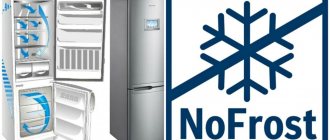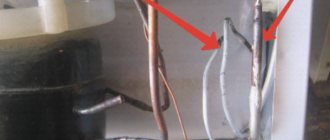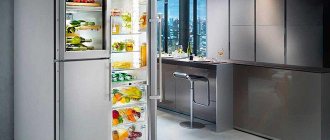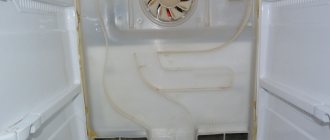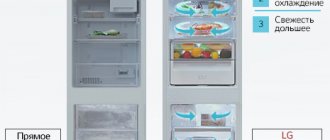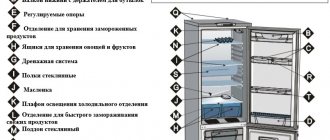Why does humidity appear in the refrigerator?
Regardless of the design of the refrigerator, excess humidity may appear in it if:
- open the door often or for a long time;
- place hot or uncovered food in it;
- do not remove a thick layer of ice from the inner surface of the chamber.
Dampness in the refrigerator can lead to the formation of mold on its walls and food, and the ice crust that builds up due to excess moisture creates additional stress on the motor.
In models with a drip system
In drip models, puddles most often appear on the bottom shelf under trays for storing vegetables and fruits. This mainly happens because the drain hole on the back wall is clogged. The humidity inside the chambers may also increase due to:
- blockage of the drainage tube;
- wear or damage to the rubber seal on the door;
- violations in the operation of the temperature sensor;
- improper placement of the refrigerator: if it is not level, the doors may be slightly skewed, letting air in.
If the blockage in the drainage hole is not removed in a timely manner, the water in it will become cloudy, an unpleasant musty smell will appear in the refrigerator compartment, and a “fur coat” of ice will form on the back wall.
In refrigerators with No Frost system
The No Frost system cools the contents of the chambers due to the movement of cold air, so water droplets practically do not form on the walls.
The need to clean the condensation in the “No Ice” refrigerator if it is used correctly occurs when the following breaks down:
- defrost sensor;
- electric heater;
- defrost timer.
Before looking for damage in one of the refrigerator components, you should check the fuses.
Even one burnt element can lead to the formation of high humidity.
Possible causes of condensation in the refrigerator
Violations of the rules for operating refrigerators
Among the most common violations are the following:
- Storing liquid products without using lids. Evaporation can lead to the formation of excess moisture in the chambers.
- Placement and storage of high temperature products. This creates an additional surface on which condensation forms due to the temperature difference.
- The door does not fit tightly due to its distortion or deformation of the sealing rubber. Keeping the door open for a long time. The increased work of the compressor, trying to cope with the warm air coming from the room, leads to the formation of ice.
Clogged drainage elements
When a blockage occurs, water returns to the chamber. It accumulates at the bottom, evaporates during the defrost cycle and settles on surfaces in the form of droplets. The blockage may be in the drain hole or in the drainage pipe. If cleaning the first one does not bring results, then most likely the problem lies in the tube.
Important! If you do not pay attention to the clogged drainage hole for a long time, the evaporator may freeze and, as a result, loss of performance of the entire refrigerator.
Violation of the tightness of the refrigerating chamber
The door should fit snugly against the refrigerator body. Thanks to this, the equipment will be provided with reliable sealing. Only a high-quality rubber seal, which is located around the perimeter of the sash, can prevent the entry of warm air from outside. If the seal has distortions, gaps, or signs of damage, the proper tightness will certainly be compromised.
What level of humidity is normal?
The normal level of humidity in a refrigerator depends on its type; this data is available in the instructions. You can determine the absence of dampness inside a device with any cooling system visually. If there is little ice in the chamber, the walls and shelves are dry, and drops of liquid appear on the back wall of the main compartment occasionally during defrosting, then the device is working correctly.
To avoid the need to remove moisture from the refrigerator, maintain an optimal microclimate inside it:
- place the contents at a distance from the walls of the chamber so as not to impede air circulation;
- do not pack shelves close to each other;
- do not put hot food inside;
- Be sure to close lids on containers and containers containing liquids or wet foods.
Devices with an electronic warning system will warn the owner of a violation of the humidity regime with light or sound signals.
On other models, the appearance of dampness must be monitored independently.
Ways to eliminate moisture
Sometimes all you need to do to get rid of humidity in a refrigerator with a drip system is to move the bottom fruit and vegetable trays a little. They should not touch the walls of the chamber.
If the cause of dampness is a clogged drain hole, then clean it with a special brush included in the kit or a medical bulb.
To remove condensation on the refrigerator partition, which has formed due to damage to the seal on the door, you need to replace it.
It is impossible to get rid of moisture in the refrigerator resulting from a broken temperature sensor on your own. You should call a technician who will replace the damaged part.
In refrigerators with a No Frost system, excess moisture can accumulate only due to damage to its components.
To get rid of moisture in the refrigerator, you need to identify the defective part and replace it. If you have no experience in repairing cooling equipment or household appliances, then it is better to entrust the matter to a specialist.
After the cause of condensation has been eliminated, clean the device from any remaining liquid and possible mold bacteria. This can be done both with ready-made drugs and using traditional methods.
Ready-made products
Store-bought preparations to eliminate the effects of excessive dampness contain aggressive chemical components, so you need to use them with rubber gloves.
After cleaning, wash the substance off the walls and shelves with soapy water, rinse the surfaces and ventilate the kitchen.
The best refrigerator disinfectants:
- “Silit Bang Black Mold Removal” - spray with active chlorine;
- "Penosaur Horse Cleaner for refrigerators" - foam for eliminating microorganisms and musty odors, safe for plastic, rubber and metal parts of the device;
- “Diabak” is a concentrated disinfectant for kitchen appliances and any household items;
- “Top House Refrigerator Cleaner” is a sprayer that cleans the internal walls of the appliance;
- “Bagi Anti-Mold” is an antibacterial spray that removes fungi and mold organisms.
Before you start cleaning the device, be sure to disconnect it from the power supply.
Traditional methods
Homemade refrigerator cleaning recipes:
- Hydrogen peroxide 3% works well against fungus and mold and disinfects device chambers, but due to its bleaching properties it is not recommended to use it on black or dark-colored parts.
- Any alcohol has a disinfectant and antifungal effect. Ammonia needs to be diluted 1:1, the rest can be used to immediately wipe the surfaces. After treatment, the refrigerator compartment does not need to be rinsed with water; it is enough to ventilate the compartment.
- Laundry soap and bleach contain alkali, which resists the formation of mildew.
- A solution of soda and vinegar helps get rid of mold and unpleasant odors in the refrigerator.
Before starting the procedure, make sure that condensation is formed within normal limits.
Finding and eliminating possible breakdowns
If all of the above methods do not bring results and condensation still forms, then the reason is damage to the device mechanism. Without experience in repairing refrigeration equipment, you should not look for and try to fix the breakdown; it is better to entrust this matter to a specialist.
In rare cases, condensation may appear due to improper assembly in production: the refrigerant circulation system touches the drain tube and freezing occurs. A repairman who will separate the parts will help you get rid of water in a refrigerator with a manufacturing defect. If the device is still under warranty, then you should contact an official service center.
Why is there high humidity in the refrigerator?
If loose ice accumulates in the refrigerator, this is the first sign of microclimate disturbance. The gas environment in the room always contains a higher percentage of humidity than in the refrigerator. Fresh portions of it get inside when the doors are opened. As the air cools, it releases dew, which is deposited on the cold surface. Subsequently, the water freezes. If you do not open the door, an equilibrium state will be established inside and there will be no ice.
Frequently opening the door, poor sealing and making edible ice will increase the humidity in the chamber. This leads to abundant formation of ice crust. Subsequently, the temperature in the chamber rises, the humidity rises, and the compressor operates under heavy load. It is completely impossible to get rid of water in the refrigerator, since it is a component of the atmosphere. The concept of “high humidity” is relative. For groups of products stored at low temperatures in refrigerators, the requirement for water content in the air is different. In the refrigerator for storing flowers, the humidity should be high, for storing food - average. To retard the development of microorganisms, dry air is needed when storing biomass. Which indicator is normal depends on the purpose of the device.
There are general principles of refrigerator operation that affect humidity:
- The higher the temperature in the chamber, the greater the equilibrium air humidity.
- Humidity depends on the cooling method. No Frost dries the air. Drip defrosting creates the most water.
- In a refrigerator with natural cooling, the temperature and water vapor content on the upper shelves is higher than on the lower ones.
From the thermodynamic calculation it is determined that the air humidity in the chamber depends on the difference between the boiling point in the evaporator and the air temperature in the chamber. The colder the contact surface, the lower the humidity inside the chamber. Based on the temperature difference, the calculated cooling capacity of the device is determined. This indicator affects which compressor and evaporator will be installed in different models of household refrigerators.
Increased humidity in the refrigerator indicates a malfunction of the seal circuit, control equipment or heat removal system. What to do? Follow the instructions and carry out diagnostics.
